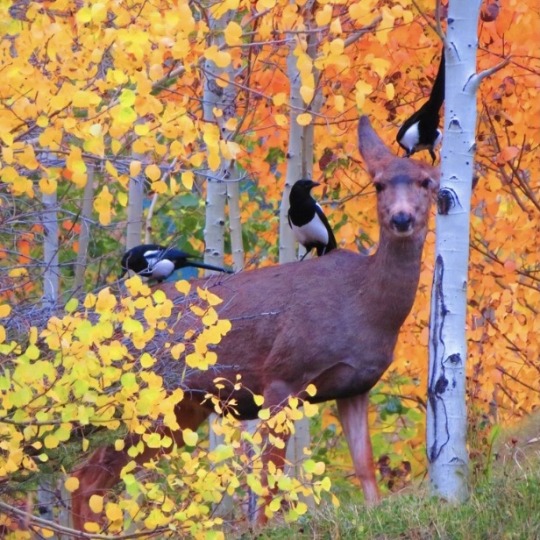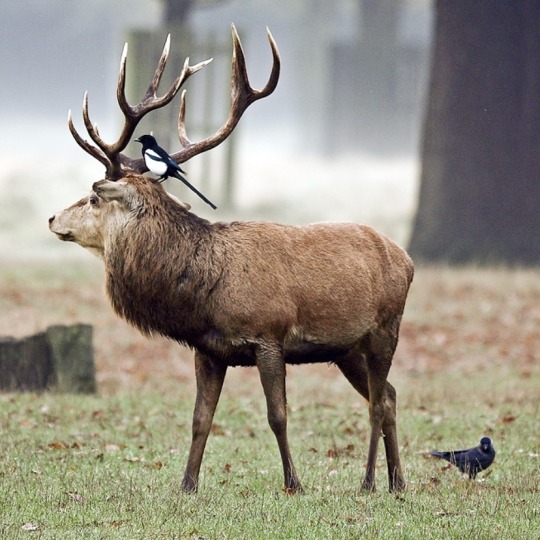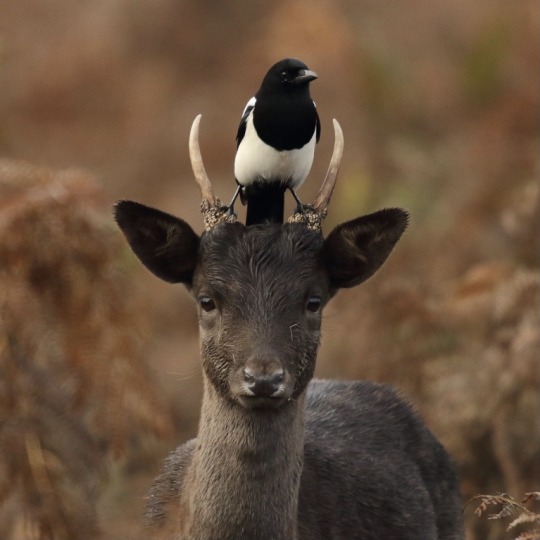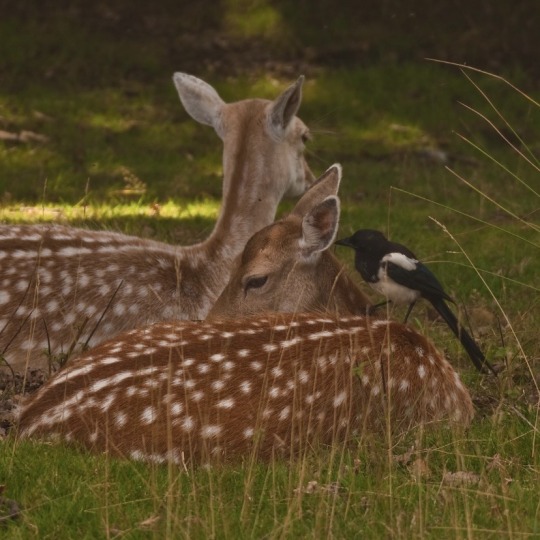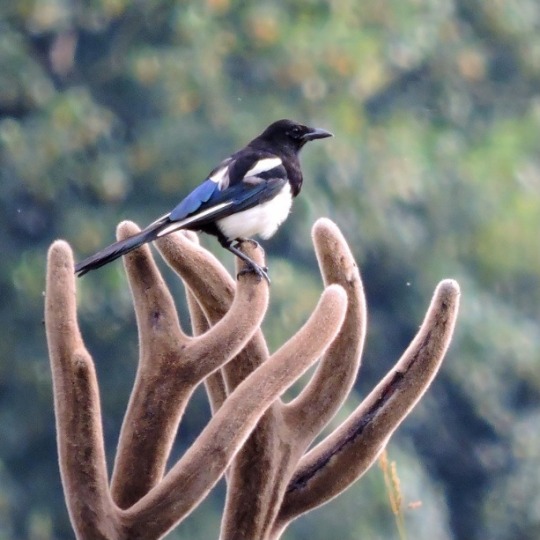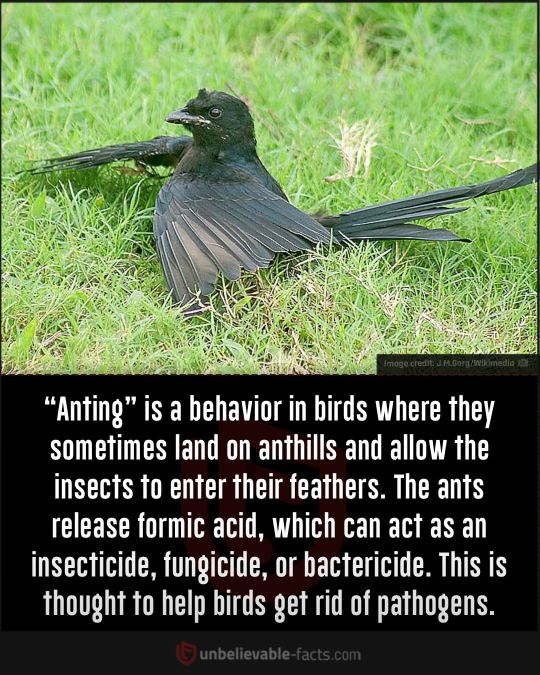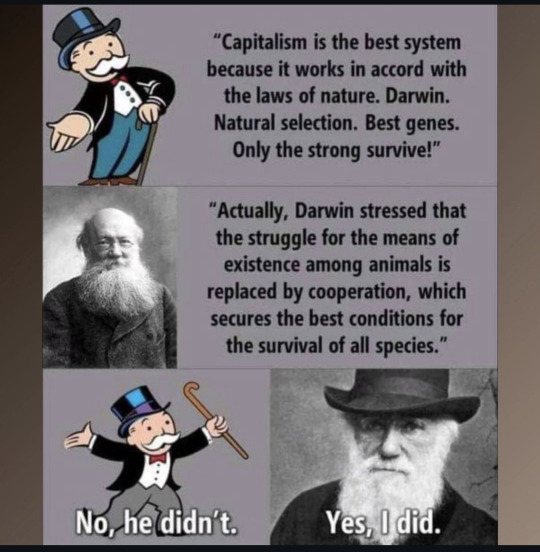#Mutualism
Note
Wait, which animals raise livestock?
Several species of ants will 'herd' aphids around (a type of plant lice)- even picking them up and putting them back with the group if they wander off. The ants will attack anything that approaches their aphid herds, defending them. The aphids produce a sugary excretion called honeydew, which the ants harvest and eat.
Some ants will even 'milk' the aphids, stroking the aphids with their antennae, to stimulate them to release honeydew. Some aphids have become 'domesticated' by the ants, and depend entirely on their caretaker ants to milk them.
When the host plant is depleted of resources and dies, the ants will pick up their herd of aphids and carry them to a new plant to feed on - a new 'pasture' if you will.
Some ants continue to care for aphids overwinter, when otherwise they'd die. The ants carry aphid eggs into their own nests, and will even go out of their way to destroy the eggs of aphid-predators, like ladybugs.
--
Microhylids – or narrow-mouthed frogs - have an interesting symbiosis with Tarantulas.
While the spiders could very easily kill and eat the much-tinier frogs, and DO normally prey on small frogs, young spiders instead will use their mouthparts to pick up the microhylid frogs, bring them back to their burrow, and release them unharmed.
The frog benefits from hanging out in/around the burrow of the tarantula, because the tarantula can scare away or eat predators that normally prey on tiny frogs, like snakes, geckos, and mantids. The tarantula gets a babysitter.
Microhylid frogs specialize in eating ants, and ants are one of the major predators of spider eggs. By eating ants, the frogs protect the spider's eggs. The frogs can also lay their eggs in the burrow, and won't be eaten by the spider.
So it's less 'livestock' and more like a housepet - a dog or a cat. You stop coyotes/eagles from hurting your little dog/cat, and in return the dog/cat keeps rats away from your baby.
--
Damselfish grow algae on rocks and corals. They defend these gardens ferociously, and will attack anything that comes too close - even humans. They spend much of their time weeding the gardens, removing unwanted algaes that might overtake their crop.
The species of algae that they cultivate is weak and and sensitive to growing conditions, and can easily be overgrazed by other herbivores. That particular algae tends to grow poorly in areas where damselfish aren't around to protect and farm it.
Damselfish will ALSO actively protect Mysidium integrum (little shrimp-like crustacians) in their reef farms, despite eating other similarly sized invertebrates. The mysids are filter feeders, who feed on zooplankton and free-floating algae, and their waste fertilizes the algae farms. Many types of zooplankton can feed on the algae crop, and the mysids prevent that.
While Mysids can be found around the world, the only place you'll find swarms of Musidium integrum is on the algae farms that Damselfish cultivate.
Damselfish treat the little mysids like some homesteaders treat ducks. Ducks eat snails and other insect pests on our crops, and their poop fertilizes the land. The ducks can be eaten, but aren't often, since they're more useful for their services than their meat.
--
There are SEVERAL species of insect and animal which actively farm. They perform fungiculture and horticulture: deliberately growing and harvesting fungus and plants at a large-scale to feed their population.
Leaf-cutter ants and Termites both chew up plant material and then seed it with a specific type of fungus. The fungus grows, and the termites/ants harvest the mushroom as a food source.
Ambrosia beetles burrow into decaying trees, hollow out little farming rooms, and introduce a specific fungii (the ambrosia fungi), which both adults and larval beetles feed on.
Marsh Periwinkles (a type of snail) cultivates fungus on cordgrass. They wound the plant with their scraping tongue, then defecate into the wound so their preferred fungus will infect it and grow there. They let the fungus grow in the wound a bit, and come back later to eat.
3K notes
·
View notes
Text
Okay. This is a pretty big deal in the world of mycology. Historically fungi have been divided up into either parasites that siphon resources from plants, mutualists that cooperate with them, or saprotrophs that break down decaying organic matter (plant and otherwise.) The genus in question, Mycena, has traditionally been made of saprotrophic species feeding on decaying wood.
However, what scientists are observing is Mycena fungi displaying primitive mutualistic behaviors, specifically providing living plants with nitrogen and getting carbon in return from a living partner, or getting to chow down on the plant's remains once deceased. This shows a significant level of adaptability that hasn't been observed in fungi beforehand, though given how much we don't know about fungi there's a good possibility this isn't an unprecedented event.
It doesn't surprise me one bit that we're seeing this in Mycena. These fungi are especially opportunistic; in fact, that mushroom growing out of a frog's skin that we saw a while back was also a Mycena species. Perhaps we need to add bonnet mushrooms to raccoons, dandelions, and other hardy generalists as symbols of scrappy survival in spite of environmental pressures.
#Mycena#bonnet mushrooms#mushrooms#mushroom#fungi#fungus#mycelium#mycology#botany#biology#nature#science#scicomm#evolution#environment#ecology#mutualism#mycorrhizal fungi
541 notes
·
View notes
Photo

I know a lot of trans people are scared for their futures right now. Do not let your spirit be crushed.
4K notes
·
View notes
Text
From the Wikipedia page on Pawpaw (Asimina triloba):
The megafaunal dispersal syndrome is a common feature of some plants native to the Western Hemisphere, where a large proportion of megafaunawent extinct near the end of the glacial episodes. Such fruits are now regarded as evolutionary anachronisms.[27] Their anatomical features, such as seeds too big for today's fruit eaters to swallow and then defecate, means they are no longer well adapted for current ecological conditions.[50]
Another indicator of dispersal adaptation for megafauna is that pawpaw fruit (wild types and most cultivars) tend to remain green or become blotched with brown when at peak ripeness. Mammals (other than primates) rely on olfactory rather than visual clues for discerning ripe fruit, so fruit color is no signal of ripeness for large mammals.
When I was out in the woods last fall and happened upon a pawpaw grove, I can testify, giving you my word as a primate, that the smell stopped me in my tracks. A grove full of ripe pawpaws is unbelievably, intoxicatingly fragrant.
Not a single pawpaw tree could be seen from the trail, but the scent was strong and enticing. I literally sniffed my way towards it. It was that way that I spotted the pawpaw grove, and derailed my plans for the entire morning climbing 50 feet down a steep hillside to reach the pawpaws in the holler below me.
"Evolutionary anachronisms?" Spoken like someone who has never taken orders from a plant! Asimina triloba has intimate knowledge of a primal part of my psyche and appetites that no other organism does. The other day I was on iNaturalist scrolling old photos and I saw a box of pawpaw fruits and immediately started salivating.
And soon, I'm taking my pawpaw saplings out to plant them next to a creek in town! I fell for it! Mutualism- the oldest trick in the book!
346 notes
·
View notes
Text
kink blogs reblogging my whump stuff with tags that make it clear they're imagining all of it as consensual 🤝 me reblogging kink content imagining it as whumpy and nonconsensual
140 notes
·
View notes
Text
Daily fish fact #469
Spotted prawn goby!

They form symbiotic relationships with pistol shrimp! The shrimp lets the goby live in its burrow, and in exchange the goby acts as a kind of watchman for the nearly blind shrimp, alerting it of predators. This kind of bond will usually last for the entire life of both animals!
#fish#fishfact#fish facts#fishblr#marine biology#marine life#marine animals#sea creatures#sea animals#sea life#biology#zoology#spotted prawn goby#spotted shrimp goby#blackchest shrimp goby#goby#goby fish#mutualism#symbiosis
390 notes
·
View notes
Quote
There is not even a thought, or an invention, which is not common property, born of the past and the present. Thousands of inventors, known and unknown, who have died in poverty, have co-operated in the invention of each of these machines which embody the genius of man.
Peter Kropotkin, The Conquest of Bread
#philosophy#quotes#Peter Kropotkin#The Conquest of Bread#invention#creation#creativity#property#mutualism#humanity
86 notes
·
View notes
Text
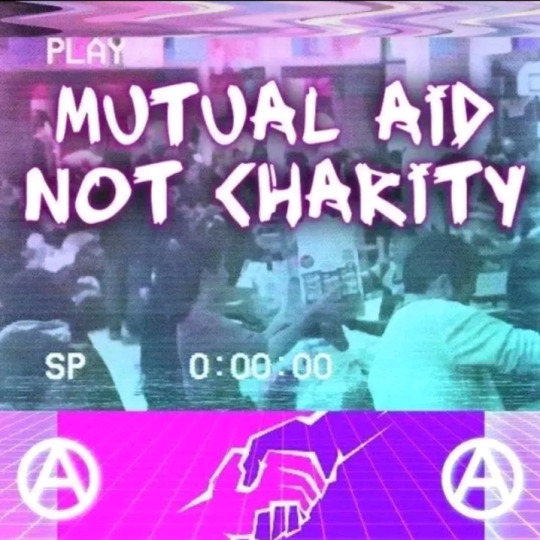
#anarchocommunism#ancom#communism#commune#liberation#mutualism#volunteer#volunteering#anarchy#anarchist
90 notes
·
View notes
Text
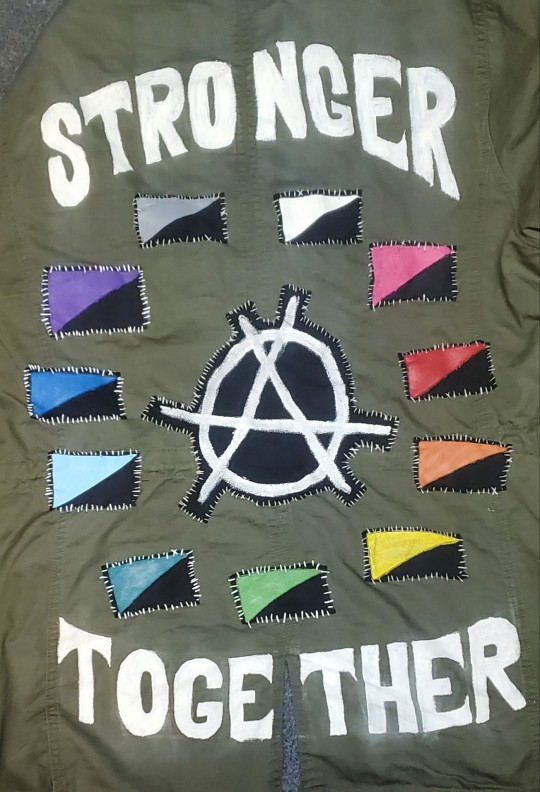
Finished the back of the unity jacket. Need to think of more to put on this one. Mainly trying to think of something to paint on the hood. Maybe a black head?
#anarchism#anarchy#market anarchism#agora#agorism#diy#punk diy#diy punk#patches#syndicalism#synthesis anarchism#individualist anarchism#social anarchism#egoism#mutualism#diy patches#diy projects#anarcho primitivism#stronger together#unity jacket#anarcho capitalism#anarcha feminism#anarcho pacifism#anarchopunk#anarcho syndicalism#anarchist#queer anarchism#anarcho communism#anarchocapitalism#anarchocommunism
40 notes
·
View notes
Text
i dont even have the capacity right now to make as robust of a post as i would like but i really think we all need to be aware of these updates regarding the stop cop city movement taking place in atlanta, georgia, united states of america. bold added for emphasis in the quotes below:
According to the state of Georgia, buying $11.91 worth of glue can land you on a RICO indictment, if the glue is used to protest the police. That’s exactly what it says in yesterday’s indictment against 61 people who have allegedly been protesting Atlanta’s potential Cop City. If you don’t know what Cop City is, it’s a plan to spend at least $90 million and destroy over 300 acres of forest to build a sprawling training center with a mock urban neighborhood to practice police tactics, specifically tactics of repression. Now, sweeping and overreaching charges claim that “militant anarchists” are engaged in a criminal conspiracy to stop this repression training center from being built. But, the indictment proceeds to lay out actions like handing out fliers, giving people food, and even running a bail fund to help arrested protesters as grounds for this case. The social media activity of people involved is referenced, simple acts of free speech are cited, and even ideas like solidarity and mutual aid are discussed as problems which somehow add to the necessity for this indictment.
...
U.S. police killed more people than ever last year and have not changed or reformed since the murder of George Floyd, and the people in Atlanta organizing against Cop City are very much aware of this. Yet instead of acknowledging the simple fact that cops should not kill, and that their power should not be endlessly expanded while they murder without consequence, the state of Georgia is instead choosing to grossly overreach. They’re instead trying to tie the movement to Stop Cop City to George Floyd and say that efforts to limit police violence are criminal rather than justified.
Regardless of whether or not activists and organizers fighting the massive police repression training center were in the streets in 2020, they are informed by the knowledge that sparked the biggest protest movement this country has ever seen: police murder without consequence, and expanding police power, means more violence, more killing, and more repression of movements to improve society. We must be clear that anyone who opposes police murders and the expansion of the police state is fighting on the side of justice. The details listed in the RICO indictment, like small Venmo charges, an individual signing their name as ACAB, and people attending a concert show that the state is very much on the other side, the side of ruthless oppression. But maybe even more clarifying is the broad, sweeping condemnation of basic tenants of human goodness. The state lists, “mutual aid, collectivism, social solidarity” as tenants of anarchism that run rampant in the movement to stop Cop City. The charges condemn, word for word, “the notion of social solidarity,” which, “relies heavily on the idea of human altruism.” In a tale as old as time, the indictment of these activists and organizers, of these people, these residents of Atlanta, is more an indictment of the state than of the movement opposed to the state’s interests. The state is revealing itself to be the real villain.
...
The state has given the people of Atlanta, and everyone opposed to the eradication of democracy, no choice but to fight tooth and nail. They have gone for the nuclear option, and in doing so have exposed themselves. They have revealed the fascist underbelly they typically try to keep hidden. They have exposed that when people exercise every democratic avenue available, and are on the verge of success, they will resort to anti-democratic tactics to crush dissent. Beyond just this RICO case, the city of Atlanta is challenging the 100,000+ signatures gathered by grassroots organizers and volunteers working their asses off. Mayor Andre Dickens and his team are using the exact same regressive signature checking and discounting strategy he formerly opposed now that he wants to ram Cop City through against popular opinion and against the democratic process.
Between the Mayor, the police, and the state, what choice do we have but to fight. When the government declares itself opposed to the very ideas of solidarity, mutual aid, and care for one another they seek to crush resistance. But instead they spark it. People everywhere are seeing the illegitimate nature of the institutions that kill, repress, and incarcerate anyone struggling for a better world. People everywhere see that institutions opposed to collectively looking out for each other, which seek to ban compassion and care with the threat of violence, have no legitimacy and must be opposed. They cannot be upheld or sustained. In a world where we need each other more than ever we can’t abide a repressive state that would rather police us into an early grave than grant us the resources we need to survive. And although it won’t be easy to overturn the system of capitalism and the violent police state that works to uphold it, we’ve been given no choice.
We will Stop Cop City in Atlanta, and we will stop every attempt to build a Cop City anywhere. Officials in other Georgia counties, Baltimore, Ohio, and elsewhere are currently proposing their own Cop Cities, mimicking what they see in Georgia and attempting to build up their capacity to suppress dissent rather than building up their capacities to help people survive and thrive. We will out organize and out mobilize and out build the oppressive systems and institutions that seek to turn this country and the planet into one large police state. We have to. Be careful, but be determined. And get organized. Solidarity.
For over seven years, the fund—a nonprofit fiscally sponsored by the Network for Strong Communities—has provided legal defense and bail support for Atlanta. For aiding #StopCopCity protesters, the three fund organizers were arrested on charges of money laundering and charity fraud.
Of what did this “fraud” consist? The warrants cited standard nonprofit reimbursements such as COVID tests and forest clean-ups in their rationale for the arrests. In the words of Kamau Franklin, an organizer with the Atlanta-based collective Community Movement Builders: “This is an arrest which is meant to, again, criminalize the movement, chill dissent, stop organizing, and stop activism from happening to stop ‘cop city’.”
In so much as the work is radical, it will be under attack. Organizing that challenges capitalism, White supremacy, policing and prisons, and imperialism always carries risk. In the case of the bail fund, for example, what can movements do in the face of state repression? Potentially by shining a light on how mutual aid funding strategies are under siege, a clearer picture may emerge of ways to protect this valuable activity.
Multiple people have noted that the Atlanta arrests represent yet another novel authoritarian and growingly fascist tactic to intimidate grassroots organizing and also draws on a long tradition of state repression against the Black freedom struggle. If successful, it could have far-reaching impacts on the swell of bail funds, abortion funds, transgender healthcare funds, and immigrant justice funds that have grown in recent years.
...
The Atlanta Solidarity Fund arrests did not occur in a vacuum. There is a long history of state repression against radical, grassroots power-building efforts—and those efforts continue today.
Historian Say Burgin and political scientist Jeanne Theoharis aptly point out that across 1960 Southern sit-ins, 1961 Freedom Riders, and 1964 Freedom Summer, bail funds were a critical organizing effort for crystallizing and sustaining solidarity action. Where politically motivated captivity for civil rights activists loomed, bail funds responded.
Mutual aid funding for these bail efforts were not just tactical, they were cultural. Mutual aid fundraising, in these contexts, gave everyday people a way to invest and engage in the very struggles they supported and needed. Mutual aid would provide yet another cultural outlet for radical, anti-repressive intent. This opportunity to mobilize people in radical efforts clarifies a threat to stakeholders in White supremacist institutions.
...
There are also increasing examples of state actors co-opting both the language and practices of mutual aid. In an interview with mutual aid organizer and writer Dean Spade, the Chicago Community Bail Fund highlighted examples of sheriffs welcoming the arrival of bail funds to support unaffordable bonds, city council-supported ordinances to protect bail funds “while continuing to take the money of Black and Brown community members paying bond for their loved ones,” and the city of New York’s own philanthropically backed bail fund created in 2017. As members of the Chicago Community Bail Fund reflected on New York’s system: “In effect, New York was funding the arrest, prosecution, and release of people caught in its criminal legal system instead of not arresting or prosecuting them in the first place.”
#reaux speaks#signal boost#stop cop city#atlanta#georgia#united states#abolition#environmental justice#intersectional environmentalism#climate change#defund the police#new york#bail fund#mutual aid#solidarity#anarchism#collectivism#mutualism#community#baltimore#maryland#ohio#acab#rico charge
107 notes
·
View notes
Text
Lichen anatomy lesson
SO I was reading through this week’s paper for my lab meeting, and I noticed it had some great visuals that explain the internal anatomy of the lichen thallus--specifically for this paper, Lobaria pulmonaria. So, here is what we see with the naked eye:

Lobaria pulmonaria is a large, foliose lichen that grows in undisturbed, old growth forests. It is a symbiotic association between an ascomycete fungus (the mycobiont), a photosynthesizing green algae (the primary photobiont), and a nitrogen-fixing cyanobacteria (the secondary photobiont). This means that L. pulmonaria is what is known as a tripartite lichen, which is pretty unique in the lichen world. If you were to cross section one of these leaf-like lobes and look at it under the microscope, here is what it would look like:

You can clearly see the structural and protective layers of fungal tissue in the upper and lower cortices and medulla, the green algal cells in the primary photobiont layer, and the cyanobacterial colonies encapsulated in the cephalodia. You can also see the tomentem. These little strings look like roots, but don’t absorb water or fix nitrogen like roots do--they just anchor the lichen to the substrate.
But let’s get even more granular:

In this schematic, you can see other members of the symbiotic community, including bacteria and lichenicolous fungi (I think it is important to note here that every living organism has colonies of associated bacteria and fungi. This is not unique to lichens). You can also see the structures that encapsulate the cyanobacteria, and as well as the make-up or soredia (vegetative reproductive propagules) containing both fungal and algal components.
Now I know some of you guys might be wondering why L. pulmonaria has 2 photobionts when many lichens get by with just 1. Well never fear, my symbiotic associates. I will let you know in a future lichen lesson, but for now enjoy these gorgeous graphics and bask in the glory of the lichen.
Grimm, M., Grube, M., Schiefelbein, U., Zühlke, D., Bernhardt, J., & Riedel, K. (2021). The lichens’ microbiota, still a mystery?. Frontiers in Microbiology, 714.
#lichen#lichens#lichenology#lichenologist#lichenized fungus#symbiosis#mutualism#biology#ecology#mycology#microbiology#algae#cyanobacteria#nature#the natural world
400 notes
·
View notes
Text
Godsend: Mutual Obsessed with That One Thing You Have Blocked Grossly and Religiously Overuses the Tumblr Tagging System, more at 7
22 notes
·
View notes
Text
Daily fish fact #301
Giant moray eel and coral grouper!
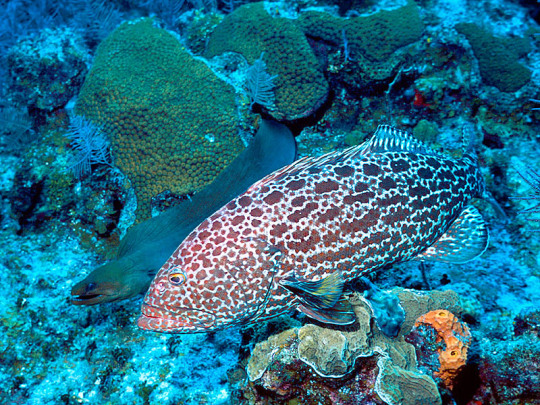
A double fact! Giant moray eels and coral groupers work together while hunting prey! When a grouper is hunting for prey that has sneaked into a tight space it can't reach, it'll find a moray eel and signal it to hunt with it! The two then work together to hunt for prey: the eel can squeeze into tight spaces and hunt in the crevices, while the grouper can easily chase down any escapees in open water. Overall, both fish get more successful hunts than they would alone, so they both benefit greatly!
#fish#fishfact#fish facts#fishblr#marine life#marine animals#marine biology#sea life#sea animals#moray eel#moray eels#eel#eels#giant moray eel#coral grouper#grouper#symbiosis#mutualism#eel and grouper
212 notes
·
View notes

